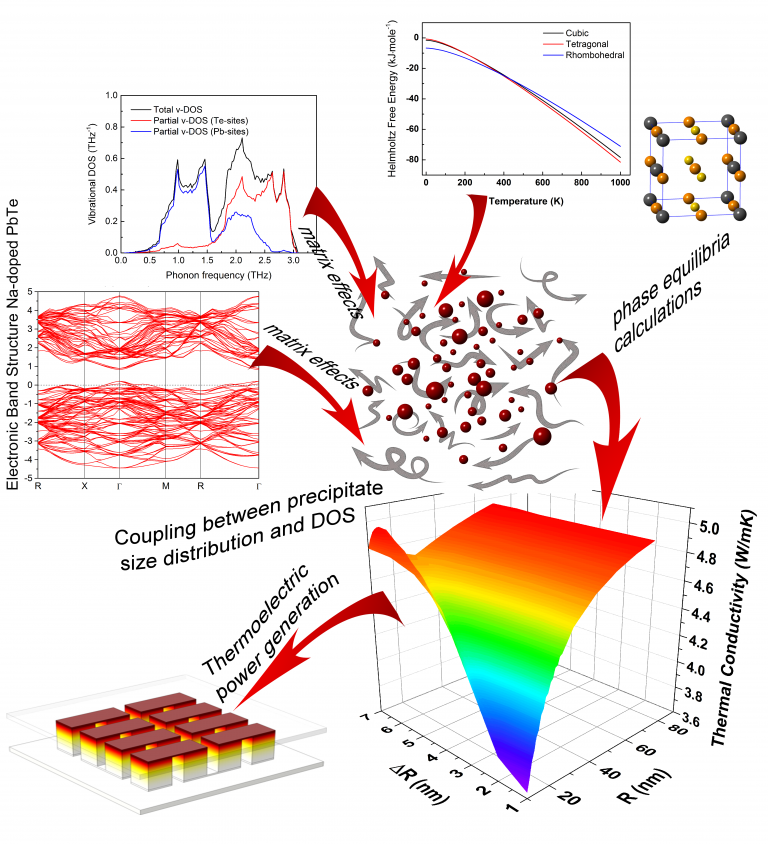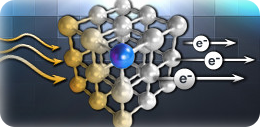Adjusting the properties of thermoelectric materials for energy applications by nanostructuring
Research Directions
One of the fundamental and intriguing questions in materials science is how to control functional properties of materials by manipulating their microstructure. An outstanding example for a functional property that is highly sensitive to the finest features of microstructure is thermoelectricity. In the thermoelectric (TE) effect thermal energy is converted into electrical energy and vice-versa. TE devices can, therefore, serve for heat-exchange or refrigerating as well as for capturing waste heat and converting it into electricity; the latter has major implications for energy harvesting.
The performance of TE materials can be improved by increasing their electrical conductivity and/or reducing their thermal conductivity. These two requirements are usually contradictory, which makes the development of TE materials a grand challenge from the materials science point of view. One of the promising approaches for reducing thermal conductivity with no deterioration of the electrical conductivity is formation of coherent nanometer- size precipitates dispersed in a TE matrix, thereby scattering of heat conducting phonons.
We process two-phase TE alloys comprising matrix and precipitates, and apply different heat treatments to obtain diverse microstructures. Supplemented by ab-initio calculations, we aim to “smartly-design” new materials processing in a time and cost-effective manner. Employing advanced characterization techniques, we analyze the materials structure and chemistry down to the nanometer length-scale. Finally, we measure the TE properties of these materials and correlate them with their microstructures. This helps us modeling the thermal conductivity in heterogeneous materials, and provides us with insight of the underlying physics. Besides possible improvements of TE properties, we endeavor to advance our understanding of how functional properties of materials depend on their microstructure.
The following are the main research directions studied at our group; the first two (1 and 2) focus on derivatives of the LAST (lead-antimony-silver-tellurium)-based TE materials, which are very promising owing to their high figure of merit and improvement potential:
- Tailoring the properties of LAST-based thermoelectric (TE) materials for energy applications by nanostructuring.
In this research area we attempt to improve the properties of Ag-Sb-Te-based TE materials by producing an AgSbTe2-polycrystalline matrix containing highly-dispersed nanoscopic Ag2Te-precipitates. This is expected to reduce thermal conductivity, thereby increasing the energy convergence efficiency of this material. - Microstructure evolution of the Ag-doped PbTe thermoelectric (TE) material for energy harvesting
Herein, we produce Ag-doped PbTe-alloys with PbTe-matrix containing homogeneously-dispersed Ag2Te-precipitates. Varying the temperature and durations of heat treatments, we manage to produce alloys having different precipitate number densities, and this helps us modeling the correlation between microstructure and the matrix’ thermal conductivity.
The following two research areas (3 and 4) deal with TE oxides, which offer great advantages owing to their structural and chemical stability at high temperatures, non-toxicity, and low-cost: - Effects of atomic plane modulations on thermal conductivity of CαMnO3-based compounds
This research direction examines the concept of controlling the material’s thermal conductivity by varying its supercell periodicity. - Novel high-temperature Ni-doped ZnO thermoelectric (TE) ceramics
We produce both Ni-doped ZnO solid solutions and two-phase ZnO-matrix/Ni-rich precipitates composites to control both thermal and electrical conductivities of the ZnO-matrix.
Modern approaches to enhance thermoelectric power generation efficiency are inspired by physical metallurgy, where second-phase precipitates dispersed in a thermoelectric matrix affect both thermal and electronic transport. Among experimental activity, the Amouyal’s Thermoelectric Materials Research Group apply both ab-initio methods and computational thermodynamics, which serve as a primary predictive tool for structural, vibrational, and electronic behavior of individual phases including thermal and charge transport properties, as well matrix/precipitate phase equilibria, with major implications for materials design.



